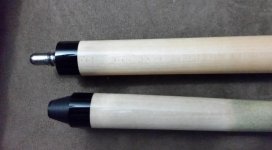Until ECF acquires some first hand cue-making experience, his academic credentials hardly qualifies him to speak of that which he apparently knows very little......but why put stock or attach importance to what cue-makers use. Why bother to look at the joints on the very best cue photos in all 3 editions of the Blue Book of Cues........or see what Azers have in their collections......or listen to the opinions of esteemed cue-makers........I mean that seems like a waste of time when we can defer to the opinion of ECF who possesses all this worldly firsthand cue-making experience.
His educational needs are so vast and great, I'd have to compose a long essay on the elements applying the greatest influence on hit -feel. There's a lot of factors that combine and create he sensation of feel starting with the shape of the tip, hardness, where on the cue ball was it struck and force of stroke, the ferrule length and composition, the shaft taper, wood compression, weight, joint type, pin type, balance point, & weight bolt (ozs), wrap - type - position or wrap-less, and assembled weight of the cue. Some heavier ivory joint pool cues tend to hit differently due to the cue's weight, ex, 19.8 ozs vs. 18.5 ozs. I found this out by owning and playing with several ivory joint cues of varying weights over the span of several years. At the same time, flat ivory joints play differently than other ivory cue joint versions. FYI..... I've recommended flat ivory joints to several Azers whom inquired how it plays and everyone seems thrilled to have made the switch.......Again, it always comes down to each his own.

